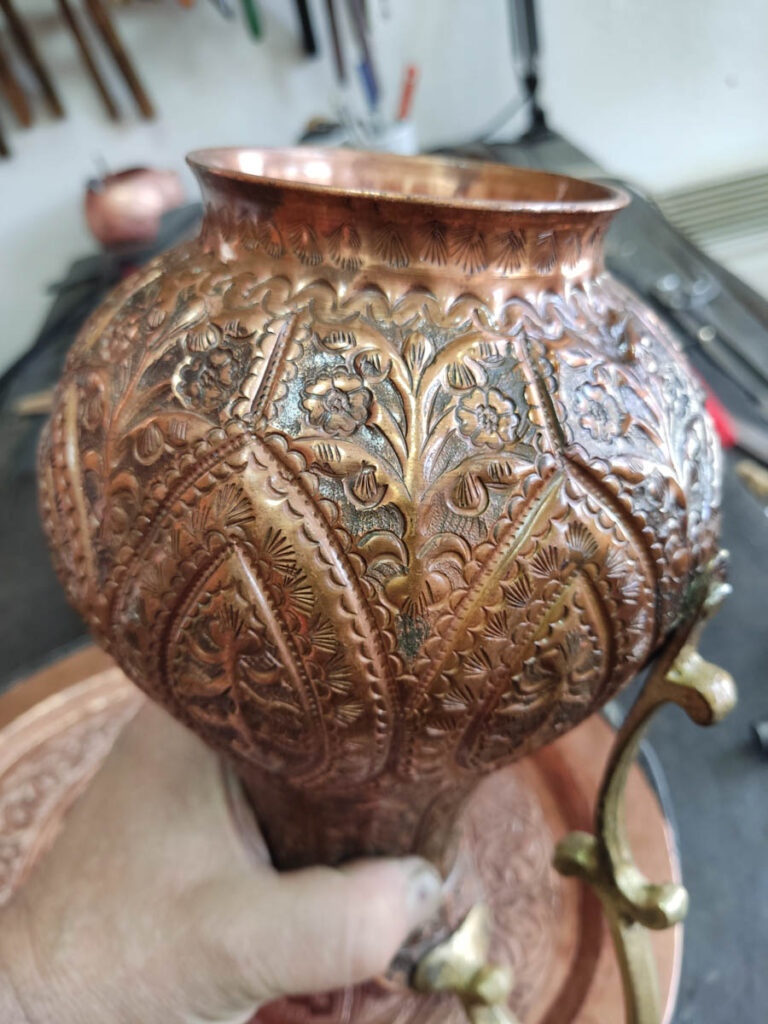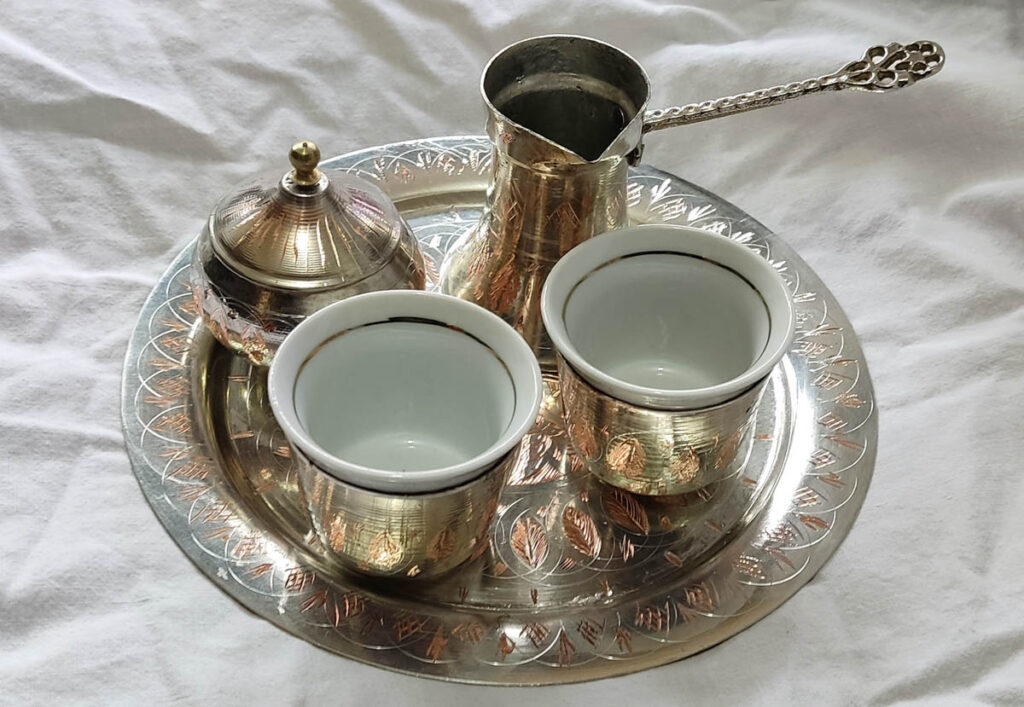Yasmin Masri delves into the world of traditional Bosnian coppersmithing with Eldin Sprečo and learns how this practice can connect through generations.
“When I make a piece in my hands, I can’t explain it,” master coppersmith Eldin Sprečo reflects, “some part of my soul, it goes in the metal.” Certainly, there is a kind of connection when holding one of Eldin’s handmade objects. Marks of where skilled hands worked before yours. Something human left behind.
Eldin Sprečo’s studio is on Kovaci, a steep street just outside of Baščaršija, the old Ottoman town centre of Sarajevo, the capital of Bosnia and Herzegovina. The studio is surrounded by similar spaces. As you climb, the sound of hammers hitting copper spills out from open doorways.
Coppersmithing has been practised in this part of the world for more than 500 years. Under Ottoman occupation, the craft grew into a respected and highly skilled profession. Before that “people made only ordinary things, like a plate for eating or a dish for soup,” Eldin tells me, the Ottomans “made a renaissance [for copper].”
Historically, many coppersmiths have had studios on Kazandziluk, a narrow cobblestone street with small workshops and stores. The street, in the heart of the Baščaršija, takes its name from kazandžijas, a term to describe master metalsmiths. Now, as tourism grows in Sarajevo, spaces for working often give way to spaces for selling and so many makers, like Eldin, have moved a little further out.
A Sudden Spark

In Bosnia and Herzegovina, coppersmithing generally runs within families as businesses are passed from fathers to sons. However, Eldin’s pathway into the craft was different. After working as a sound engineer at a TV station in Sarajevo for 17 years, Eldin developed a sudden fascination with copper. “It [was] like a flash” he tells me.
One day, a colleague who lived nearby visited while Eldin was working on a copper item in his garden. “He asked me, ‘What are you doing?’” Eldin recalls. “I was working with a screwdriver, which is so embarrassing for me [now]. I didn’t know anything about copper [then].”
Eldin’s colleague suggested he meet his grandfather, who was a local master coppersmith, “[he told me] ‘you could learn something from him’.” After thinking about it for a few days, Eldin went to visit the master one morning. They hit it off – “I stayed for two and a half years.”
Eldin’s new master had a studio in his garden. While it was just a simple workshop, for Eldin, it was a space of wonder and learning. During his apprenticeship, Eldin often woke up in the middle of the night thinking of new things to try with copper. “It’s a passion.”
At the start, tools and processes felt unfamiliar and unwieldy. “I’ve never taken a hammer like this in my hand before,” Eldin recalls. But slowly, he learned new ways of moving with the material. How much pressure to apply. What angle to hammer from. The tools became extensions of Eldin’s hands. A way to explore his curiosity and turn ideas into a physical reality. “Shaping metal, bending metal, hammering metal. It is fascinating for me”
Form and Surface
Perhaps the most archetypal copper item in Sarajevo is the džezva: a pot for making thick, Turkish-style coffee. For Eldin, coffee is an important ritual in his day, “I wake up early and drink coffee with my wife. It is some kind of social moment in my country.” The trick to making a great brew? “Try boiling the water twice,” Eldin tells me, “you [will] have coffee like chocolate.”
The base of a džezva is wide, narrowing as it gets higher. Towards the top of the pot, the form widens again and an indent or open spout is created to guide the liquid. A long brass handle is then attached. Delicate fingers kept away from the hot copper.
Sometimes the džezva is curved, nestling into the palm of your hand. Other times, it is sharper and more angular. Size varies depending on how many people are drinking together. Sometimes the džezvas are plain. Other times they are covered in ornate decoration: twisting scrolls, blooming flowers.
While Eldin often makes traditional forms, he also likes to experiment. “‘I like very strange shapes … I’m so happy when I make something different.” Often these experiments start with a flat disc of copper. Using a hammer and applying force to add dimension: the form emerges.
“When I make things with my hands, I never know what I will make,” Eldin tells me. “Maybe when I start [I think it will be] a cup for coffee, but in the end it is a cup for something else, or maybe a box for jewellery. … I enjoy that.” During these experiments, the function comes from the form. How it might physically feel to use the object for a particular purpose.
For Eldin, the shape of the copper form tells him what should go on the surface: “I exactly know.” Many of his patterns reference his local heritage. Eldin often uses embossing techniques like repoussé (raising metal by hammering from the reverse side) and chasing (hammering from the front to lower or indent metal). These processes add texture and undulation – “you can touch that, it’s very important.”
Tinning, Retinning: Layered Hands
Copperware made for cooking and serving food, such as a džezva, is normally covered in tin. This metal coating protects against damage from acidic foods, and stops the copper leaching into cooking when heated. Beyond this, the tin creates a smooth “non-stick” surface.
The process of applying tin is a delicate one. The object is heated, creating a surface that is just the right temperature. Soft enough to melt tin, but not so hot as to tarnish copper. Eldin explains, “When you want to tin something, you need very slow fire. Not too much. Not too strong.” In this process “the tin is a rod, like a pencil in your hand.”
As the tin is pressed into the hot copper surface, it liquifies. Eldin shows me how he then spreads the melted metal with scrunched-up cotton. You must be quick, moving before it cools and hardens. You must press carefully and consistently to create an even coating.
Sometimes, when tin is applied, that is where things finish. Other times, on the outer surfaces of decorative objects, the materiality of the copper below is revealed through a cutting process. “When you put tin on top of copper [and engrave], you see everything [underneath].” Orange lines on a silver background. Fine grooves under fingers.
But, tin is a soft metal. Over time, the coating is rubbed away by use. The life of the copper item can be extended through a process of reapplying the protective surface, known as retinning. This activity is “very similar to restoration” Eldin tells me. Old tin is removed. The object is cleaned. New tin is applied.
Retinning requires an intimate engagement with the item being restored. There is a careful examination: holding, turning, exploring. Learning of each bend, each join, each line. Through this process, the hands of the restorer follow the hands of the maker. New marks are laid over old ones: an addition, rather than erasure.
For Eldin, this restoration work is one of his greatest sources of inspiration. “I like re-tinning very old plates,” he tells me, “it’s a way I can learn something from the old masters from 200, 300, 500 years ago.” The object becomes a map of where someone else held, pressed, shaped.
This work becomes even more intricate, and more difficult, when restoring items with lots of engraving. The process is a careful one, “you need to make every line you see [match the one] underneath.” Grooves on top of grooves. It is, unsurprisingly, slow work. As Eldin explains, “I need time for that … maybe sometimes three days or a week.”
While this kind of restoration work is not cheap, many people in Bosnia and Herzegovina are happy to pay. These objects are not made for one lifetime. Rather, as Eldin tells me, “copper is a family treasure,” connecting generations.
About Yasmin Masri
 Yasmin Masri likes working at the intersection of creativity, community and place. She has started and run festivals, developed and delivered cultural strategy, facilitated community engagement, and produced countless exhibitions, events, pop-ups and creative projects. She also has an independent art practice, which you can see at www.yasminmasri.com.
Yasmin Masri likes working at the intersection of creativity, community and place. She has started and run festivals, developed and delivered cultural strategy, facilitated community engagement, and produced countless exhibitions, events, pop-ups and creative projects. She also has an independent art practice, which you can see at www.yasminmasri.com.



